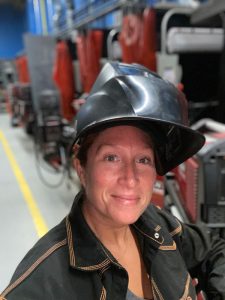For almost 25 years Lilly Lazare-Greene worked as a bartender in downtown Toronto and for the most part she loved the job. But she was laid off when COVID-19 hit, forcing bars to close.
For the single mother it was an especially difficult time, with Canada Emergency Response Benefit (CERB) payments her only financial lifeline.
“I realized that I couldn’t live like this. I needed to make a change. I needed stability,” he says.
Then, in what she describes as a “lightbulb moment,” she decided to pursue a construction trade.
She submitted an application to ontariocolleges.ca, even though she didn’t have the money to pay the $125 processing fee.
“But I decided that this (a trade) might change my life.”
After applying to several different colleges and considering several different programs, she was accepted into George Brown College’s Welding Techniques T166, a one-year, two-semester certificate program.
“Welding seemed like the coolest trade to learn,” she states.
As a member of the Mississaugas of the Credit First Nation, she was able to receive financial support from the nation and a bursary from Indspire, a national Indigenous registered charity, to defray the almost $8,500 tuition.
In May 2022 Lazare-Greene’s studies began. A mix of theoretical and hands-on instruction, the program is designed so students can master five of the most common types of welding processes: shielded metal arc; gas metal arc; gas tungsten arc; plasma arc and oxyfuel cutting; and fabrication. Other subjects include mathematics, metallurgy and blueprints.

Just before graduation in December 2022, she applied for a part-time welding technician’s position with the college and was hired the following month. Then, in August 2023, a new career door opened. A colleague recommended her as an emergency fill-in position as a lab operations development technologist. Initially a contract position, it progressed into full-time this past January.
In that role she oversees the operation of three welding shops, a fabrication shop and a millwright shop, but still has the opportunity to perform some welding tasks.
“I have been fulltime for six months now and everything is running smoothly,” she says.
Asked about the thread that links bartending with welding, Lazare-Greene says there are many similarities.
“You’re standing on your feet all the time. It’s a hot environment. You have to keep your cool, and have to be a multi-tasker.”
In reviewing that transition, Lazare-Greene says she has found her “forever career” and encourages women who may be considering a trade to pursue that goal no matter what circumstances they may be dealing with in life.
The opportunities that have risen for Lazare-Greene are not unlike those other welding techniques graduates have experienced, says George Brown College’s chair of the school of apprenticeship and trades, Dev Baichan.
“There is a strong demand for welders. With the exception of electrical (work), welding is involved in almost every aspect of construction and also bleeds into so many other sectors such as automotive and manufacturing.”
The college admits 28 students into the program each year. The admission requirements include an Ontario Secondary School Diploma, with strong proficiency in English and mathematics. Older applicants with no OSSD can apply for mature student status.
“We have a wide range of (applicants) including high school students, international students, and those interested in a career change,” says Baichan.
Industry professionals deliver the training in the college’s Canadian Welding Bureau-certified labs. At the end of the “intense” program successful graduates receive a Shielded Metal Arc Welding Flat Position Ticket. They also have the option of verifying their welding proficiency by performing a series of rigorous practical tests overseen by a Canadian Welding Bureau representative, says Baichan.
Not every graduate takes the test and some don’t actually pursue welding careers. With the knowledge and skill they have acquired, some use it as stepping stone in welding-related sales and marketing positions, he says.
Under the Apprenticeship Act, welding is a non-compulsory trade and that means anyone can work in the trade without completing an apprenticeship or passing a certification exam. But some employers may require apprenticeship training through Skills Ontario. Upon successful completion of the three-level, 6,000-hour program students can apply to write the Red Seal exam.



Recent Comments